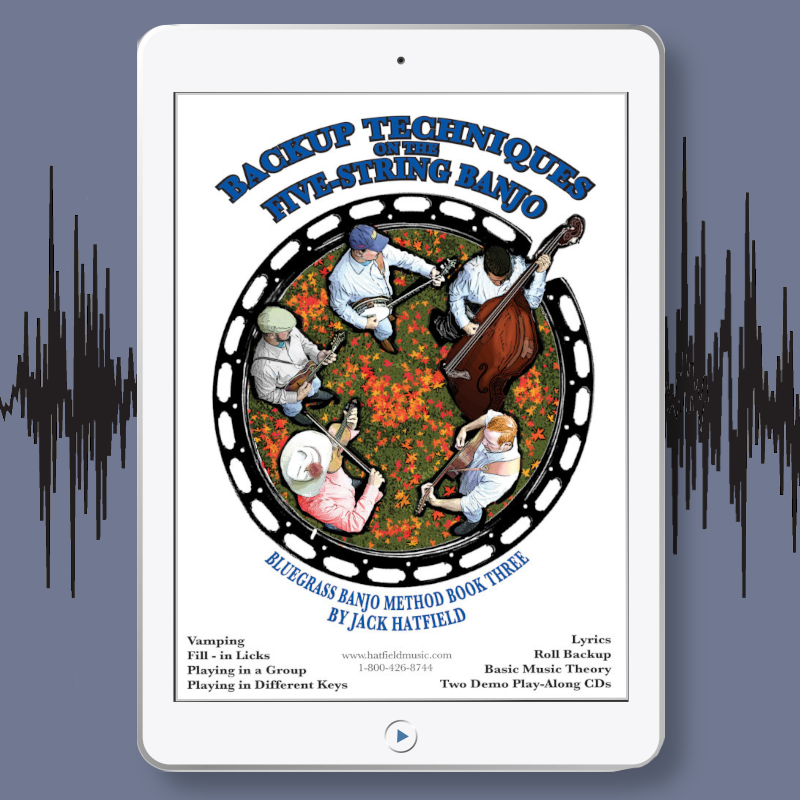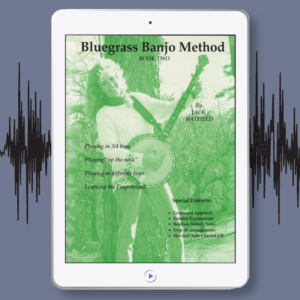THIS IS A DIGITAL PDF/MP3 DOWNLOAD SET. (Find the physical book/CD set here.)
SET CONTAINS PDF BOOK AND MP3 AUDIO TRACKS (160 minutes!)
Long-awaited book by Jack Hatfield. PDF book is 231 pages, with more than 100 tracks of play-along with full band in one channel and banjo in the other. All songs include backup. Solos included to many songs in Bluegrass Banjo Method, Book One and Bluegrass Banjo Method, Book Two as well as many new songs, including lead breaks. Tracks for “music minus one” playing along.
Includes lyrics, vamping, down and up-the- neck roll backup, fill licks, chord locating system, composing tasteful arrangements, the number system, basic music theory, backup in 3/4 time, transposing, and playing lead in different keys…many tips not found in other manuals.
Selections:
- All the Good Times
- Amazing Grace
- Battle Hymn of the Republic (in C)
- Banks of the Ohio
- Bill Cheatham
- Bury Me Beneath the Willow (G and Gm)
- Coming ‘Round the Mountain
- Cripple Creek
- Cumberland Gap (in C)
- D Banjo Boogie
- Don’t This Road Look Rough and Rocky
- Down Yonder
- Handsome Molly
- House of the Rising Sun
- In the Pines
- I’ll Fly Away (in G and D)
- John Hardy
- Little Maggie (in G and Gm)
- Lonesone Road Blues
- Make Me a Pallet on Your Floor
- Mountain Dew
- My Old Kentucky Home
- Old Joe Clark
- Roll in My Sweet Baby’s Arms (in C)
- Sail Away Ladies
- Salty Dog Blues
- Shady Grove (in G and Gm)
- Sitting on Top of the World
- Sourwood Mountain
- Tom Dooley
- Two-Dollar Bill
- Twelve Bar Blues (in G, D, A and E)
- Wafaring Stranger
- Will the Circle Be Unbroken
Banjo Newsletter Review by Wayne Shrubsall:
Readers of BNL know Jack Hatfield for his columns on Scruggs Style banjo, Beginning Banjo, and the more recent Concepts and Systems. Others know him for his two excellent banjo instruction books, “Bluegrass Banjo Method Book One” and “Book Two.” Easterners have seen Jack at the SPBGMA/BNL banjo workshops in Nashville and at the Tennessee Banjo Academy and his own Smoky Mountain Banjo Academy banjo camp. This guy knows banjo, and his new text Back-up Techniques On The Five-String Banjo: Bluegrass Banjo Method Book Three shows this admirably.
In “Back-up Techniques,” Jack Hatfield has given us a very first-rate book on how to play backup bluegrass banjo. The Table of Contents (4 pages long in small print!) arranges the text as follows:
Chap. 1: The Bluegrass Band Sound
Chap. 2: Vamping
Chap. 3: Roll Back-up
Chap. 4: Fill Licks
Chap. 5: Composing Tasteful Arrangements
Chap. 6: Basic Music Theory
Chap. 7: Playing in Different Keys
But in each chapter is a wonderful selection of examples, exercises, theory (very practical, for the most part).
Take the first chapter as an example of a valuable set of tips and instructions. The subheadings of this one chapter should be required study for any person who brings a banjo into a jam session or a band. Check out these sub-headings:
• Defining the chord
• Bluegrass instruments: compliment and contrast
• Fiddle and Banjo
• Exercising Good Taste (Whoa! Where has that one been?)
• The Roles of the Bluegrass Instruments (not the “rolls”)
• Kickoffs
• “Feature” Tunes (would you recognize Foggy Mountian Breakdown kicked off on mandolin?)
• A Word about Originality
• Maintaining Order in a Jam Session
• Variations in Band Rhythm
• Rhythm Breathes (great on rhythmic styles of different musical forms)
• Controlling Note Spacing
• Playing with Expression
• Working the Microphone
These subheadings are themselves worthy of the price of the book. Hatfield’s ideas on taste and politeness are things that are worth learning right away. All banjoists following these tips could signal the demise of banjo jokes.
After Chapter One has been read—several times—the student is ready for vamping (Chapter 2). Vamping is the basic idea of rhythm, here as played on 5-string banjo. But Hatfield presents more than just a Boom-Chuk approach to vamping. In this chapter, one studies bass notes in vamping, split-bar vamping (going from an F-chord form to a D-chord form in a harmonic sequence), playing with bounce, using turnarounds, using passing tones, and many other sub-headings. It sounds a bit confusing; but it is not, as Hatfield manages to clarify and explain and illustrate all of these sub-headings with exercises and examples.
Often, students and jam session folks “just want to vamp” as back-up. Well, proceed through Chapter 2 and you’ll have a bachelor’s degree in back-up, because you will learn all those secrets that professional banjoists, the ones who use vamping, know. For instance, if you learn Hatfield’s back-up arrangement of Handsome Molly, you’ll have learned the two chord-form of vamping and also the vamping use of passing tones. Again, if you work through Chapter 2, playing every exercise and memorizing the forms and ideas (why wouldn’t you?), then you will be ready for Chapter 3.
Like the way some banjoists use rolls as back-up? So does Hatfield, and he presents many roll techniques, again each one appropriately illustrated. Here one can pursue fast-change-progressions rolls, rolls “up the neck,” moving from major keys to 7th keys pinch-triplet backup, arpeggio backup, and roll backup in 3/4 time—among other valuable subdivisions. If you are not sure about what these things mean, the examples and text make them clear, and quickly so.
One of my favorite chapters is 4, on Fill Licks. To my ear, playing fill licks at the right time defines a good banjoist. Hatfield provides G/D fill licks, up-the-neck fills, D formation fills, F formation fills, Bar-formation fills, and other approaches to fills. [See Figure 1]. Learning these techniques makes for good music, and used properly, the banjoist will not have to be politely reminded that “the banjo is a very loud instrument.”
Another valuable chapter for fledgling banjoists is Chapter 5, in which Jack presents four full band arrangements of bluegrass standards: Sitting on Top of the World, Lonesome Road Blues, Don’t This Road Look Rough and Rocky, and I’ll Fly Away. These standards illustrate the formulas for many other bluegrass songs. In these arrangements, one has a country blues, an instrumental (or vocal), an old love lyric, and a gospel piece. Right there, one has a good chunk of the basic bluegrass band repertoire. The arrangements feature banjo solos as well as back-up, just as a band might play the tunes from start to finish. [See Figure 2.]
Now: if you enjoy the theory of music, that is, learning what is involved with music harmony and melody (and not just bluegrass), as well as learning to hear chords and chord changes by ear, Chapter 6 is the one for you. But stand warned: music theory is heady stuff, headier than some might be ready for. Hatfield makes theory enjoyable, though, and definitely readable. When you finish this chapter, you will be acquainted with theory and recognize the theory of music in your own playing.
Hatfield’s final chapter involves playing backup in different keys…Hatfield focuses on transposing from one key to another, playing in different modes…and transitioning from C Major to A minor.
Just about everything one needs to know about playing bluegrass banjo backup is in this text. In addition to the easy-to-read text, and the many examples and tabs, Hatfield provided two CDs that that not only illustrate the examples and tabs, but also provides full-band arrangements and sample backup for many tunes covered in the text itself.
It’s really a fat book, spiral bound, full of valuable tips fo all banjoists, not only people who want to expand their knowledge of how to to play accompaniment and not just licks and solos. “Backup Techniques” costs a mere thirty five dollars. Think about it: some bridges cost that much…The information in the book makes makes the cost of the book an immense bargain…Confused about backup? Then dispel the confusion and get this book!


